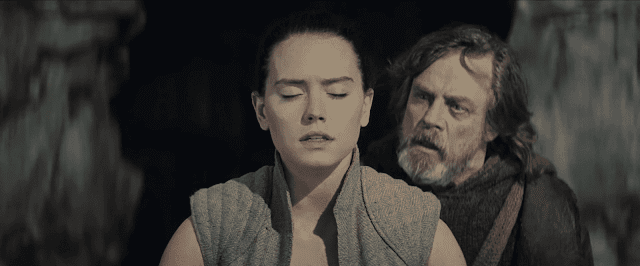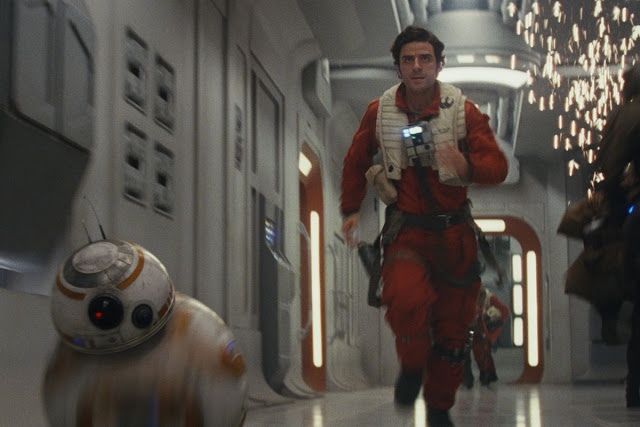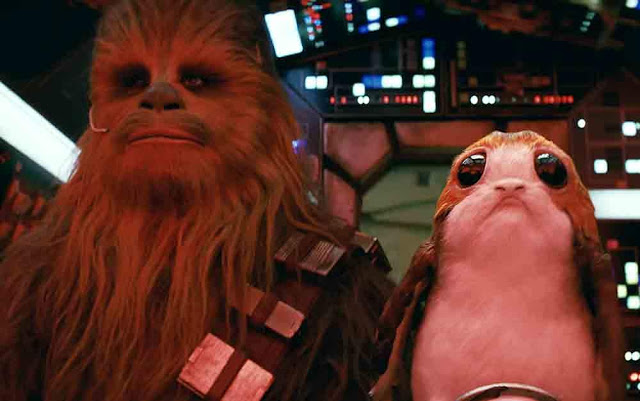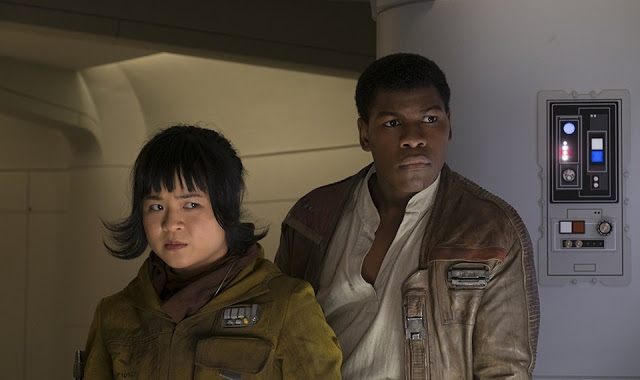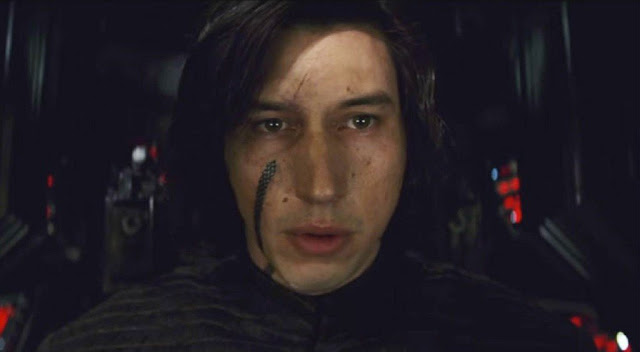For all its deafening noise and frantic activity, Star Wars: The Force Awakens concluded with a quiet and surprisingly stirring image: the aspiring Jedi named Rey (Daisy Ridley) tentatively approaching the long-vanished Luke Skywalker (Mark Hamill, as if you didn’t already know), reaching out to offer him his cherished lightsaber. It was a tantalizing ending, one that sent Star Wars fans—a sect that, according to the box-office receipts, appears to constitute most of the known world—into a state of delirious anticipation that has persisted for two full years. So it is difficult to exaggerate the audacity with which The Last Jedi, the eighth episode in the Star Wars saga (excluding the standalone Rogue One), chooses to resume this fateful encounter set on the verdant island planet of Ahch-To. Rather than expressing gratitude or even curiosity toward Rey’s arrival, Luke simply accepts the weapon, grimaces, and promptly flings it over a cliff.
This is a hilarious scene, a swift and brutal undercutting of fans’ long-gestating expectations. Yet it also symbolizes the refreshing streak of independence that Rian Johnson, The Last Jedi’s fearless writer and director, has brought to cinema’s most gargantuan franchise. The Force Awakens was a fun and spirited adventure, but it also felt somewhat safe, J.J. Abrams carefully returning the enterprise to the tracks that George Lucas’ (unfairly) maligned prequels so gleefully leapt off. The Last Jedi, by contrast, is a more interesting and exciting movie, flawed in its own ways but charged with genuine unpredictability and risk. In taking the reins from Abrams, Johnson pledges fealty to no one—not even Star Wars fans.
Not to suggest that he is unappreciative of the series’ four-decade history. Johnson, for all his skill and daring, is plainly a fan, and he recognizes the indescribable, genetically encoded thrill that viewers of a certain age receive when seeing Luke Skywalker stare mournfully into a binary sunset, or when watching the Millennium Falcon pirouette through the tiniest of crevices. In broad terms, he retains the franchise’s focus on the same key themes: the corruptive and seductive influence of evil; the need for teamwork and sacrifice; the corny, decidedly appealing notion that hope is a spark that can never be extinguished, and that no lost soul is beyond redemption. In telling his bold new story, Johnson stays true to these tenets; he simply perpetuates them in unexpected ways.
Or maybe he just copies from a better movie. Whereas The Force Awakens hewed perhaps unhealthily close to the very first Star Wars film, A New Hope, this one strongly echoes the original’s first sequel, The Empire Strikes Back (still the franchise’s best entry). As in that film, The Last Jedi scatters its scrappy underdog heroes across the galaxy, cross-cutting between their various predicaments with vim and precision. Ahch-To is a greener and prettier place than the swampy Dagobah, but Rey’s inevitable Jedi training from Luke—the hardened master eventually relents enough to relay some basic pointers on the Force, though he never entirely drops his amusingly pained expression—obviously recalls Skywalker’s own tutelage at the hands of Yoda (Frank Oz, and charming in a cameo he is), right down to a treacherous cavern that pulsates with the menace of the Dark Side. And a climactic melee on a salt-blanketed planet called Crait, with small resistance speeders racing toward towering imperial forces, evokes Empire’s majestic Battle of Hoth, which introduced those wondrous AT-AT walkers as they lumbered across a frozen landscape toward a brittle rebel outpost.
The familiarity can be distracting, but Johnson slyly tweaks the blueprint, both narratively and visually. As an auteur, he’s probably best known for his prose—his debut feature, Brick, remains a tour de force of combative wordplay—but Looper revealed him as a confident stylist with a showman’s flair. And The Last Jedi features some of the grandest imagery in the entire Star Wars canon, Steve Yedlin’s cinematography delivering one astonishing shot after another: tiny vessels zooming across a white plain, leaving billows of red smoke in their wake; a man meditating on a cliff’s edge, silhouetted against the distant sun; swordsmen slashing in a haunted throne room, the blood-red walls contributing to the yawning sense of negative space. The special effects are, of course, impressive, but Johnson makes sure not to be overwhelmed by them; instead, he combines technological might with a painterly eye and the bountiful beauty of the natural world.
He also exhibits a delightfully playful sense of humor—an early conversation between ace pilot Poe Dameron (Oscar Isaac, still great, and still slightly underserved) and snooty General Hux (Domhnall Gleeson, faring better this time around) is hysterical in its tension-cutting—as well as an unabashed love of creatures. Ever since Luke and Obi-Wan cavorted in the Mos Eisley cantina, the Star Wars pictures have been on the forefront of inventive animal design, and The Last Jedi extends that legacy of glorious oddness. For months after the trailer dropped, the internet was awash in gifs of porgs, those glassy-eyed puffin-esque yelpers whose sheer adorableness does not disappoint. But the porgs hardly have a monopoly on the film’s exotic strangeness; Crait hosts a species of rabbit-quick, porcupine-fox hybrids with ice crystals for quills, while Ahch-To is home to a group of so-called Caretakers, essentially snouted dino-nuns who drearily clean up after Luke and who view the interloping Rey as a severe nuisance. Johnson has great fun with these flesh-and-blood beings, and he also maintains the franchise’s abiding affection for sentient droids, even throwing in a malevolent, black-bodied counterpart to Poe’s beloved BB-8.
With all of these creatures and environments on display, you might expect The Last Jedi to feel overstuffed, but while the movie is certainly eventful, it’s never too busy; if anything, its opening act can feel a bit rudderless, as its primary plot involves one giant spaceship slowly creeping after a second, slightly-less-giant spaceship. The leader of the latter craft is Princess General Leia (Carrie Fisher, RIP), whose Resistance army—following a thrilling bombing run orchestrated by Poe, in which a few minuscule kamikaze fighters bring down a massive imperial monstrosity called a Dreadnought—has seemingly dwindled to just a handful of intrepid soldiers. They’re being pursued by Hux and the First Order, and their demise seems assured once Poe learns that their enemies can follow them through hyperspace via means of a complex tracking device. Following some lightning-quick exposition (hi, Lupita Nyong’o!), Poe determines that the Resistance’s salvation depends upon finding a “master codebreaker” who can secretly swap out the tracker for a dud; he thus dispatches his best bud Finn (John Boyega, excellent) and Finn’s new admirer-judger, Rose (Kelly Marie Tran, fitting in nicely), to the distant planet of Canto Bight, where the only known such codebreaker resides.
As adventure setups go, The Last Jedi’s is unnecessarily elaborate, but Johnson streamlines the jargonistic narrative with relative economy. That said, he seems unsure of what to do with Poe, who remains marooned with the principal Resistance and chafes against the orders of its second-in-command, Vice Admiral Holdo (Laura Dern, adding a pale fuchsia to her 2017 wig collection), whom he perceives as passive and weak. There’s a kernel of intrigue in Poe’s subplot here, exploring the line between bravery and recklessness—and illustrating that there are multiple strains of heroism—but it never ripens into a meaningful theme. Isaac is an exceptional actor, and Poe is billed as a phenomenal pilot; in Episode IX, it’s time to really let him fly.
More engaging are Finn and Rose’s bumbling exploits on Canto Bight, a Vegas-y world of opulent casinos and stratified citizens. Their hectic escapades—which involve a frenzied chase, a shadowy thief (Benicio Del Toro, strange and slippery), and BB-8 temporarily turning into a vending machine—are somewhat manic, but they also have an exuberant feel that prevents the movie from feeling too grave or dour.
Still, they can’t help but feel insignificant next to The Last Jedi’s central storyline, which begins on a planet that’s virtually devoid of sci-fi trappings. Luke Skywalker was hardly the original trilogy’s strongest character—he was most interesting when he was overmatched, which wasn’t all that often outside of Empire—but Johnson and Hamill have together refashioned him here as a grizzled old man who’s wary, weary, and perpetually irritated. That leads to some splendid teacher-student comedy between Luke and Rey—Luke’s disgust when his pupil takes literally his instruction to “reach out” is priceless—but it also lays the foundation for an arc of gentle potency, one in which the legendary warrior recognizes his own limitations and appreciates the need to pass the torch.
Pass it he does, as the most fascinating relationship in The Last Jedi—a dynamic quivering with unsteady attraction and fraught conflict—is that between Rey and Kylo Ren (Adam Driver), the Darth Vader wannabe who ended The Force Awakens by embracing the Dark Side and slaying his father. Kylo surely believed that patricide qualified him for an automatic promotion among the First Order’s elite, but when we first see him here, he’s getting dressed down by Supreme Leader Snoke (Andy Serkis), who castigates him for betraying flickers of pity and humanity. Kylo’s response—after first furiously ripping apart his mask, a childish tantrum loaded with drama and symbolism—is to resolve to eradicate the Resistance and thus satisfactorily demonstrate his brutality. Such cruelty would make him an unlikely match for the hopeful and idealistic Rey, and yet, at various points during her Jedi training, Rey’s surroundings suddenly melt away, and she finds herself able to see and address (but not touch) Kylo, even though they’re stationed on different worlds.
“Why is the Force connecting us?” Kylo muses to Rey. I don’t know, but I’m glad it did, because their interplanetary conversations—think Skype: Galactic Edition—are unlike anything I’ve seen in a Star Wars movie. Johnson stages these prosaic chats with a dramatic lack of effect, hushing the film’s otherwise bristling sound design, so that they paradoxically develop their own instantly identifiable style and hue. The actors help the sell; Ridley is achingly vulnerable as Rey, while Driver nails Kylo’s transition from internally wracked villain to frighteningly ambitious megalomaniac.
The complex, elastic connection between Rey and Kylo also probes deeper into The Last Jedi’s preoccupation with good and evil, inquiring whether the two are fully opposite poles or may instead mingle into fluid shades of grey. Are Rey and Kylo mortal enemies or star-crossed lovers? Members of a pitiless master race or noble guardians of peace? The answers remain opaque, at least until the characters finally occupy the same space in Snoke’s scarlet lair. That’s the setting for the movie’s most invigorating sequence, a multi-party lightsaber-wielding duel that suggests a similar scene in Return of the Jedi, but that here serves as a seismic turning point rather than a climax.
In fact, the climax lies some distance away; The Last Jedi is a long film, with Johnson allowing momentum to build rather than worrying about alienating impatient viewers. The strategy pays off. The movie’s final act is its best, Johnson brilliantly fusing classical action tropes with the Star Wars universe’s highly particularized mythology. (His dogfights are sensibly choreographed without feeling labored, striking a tricky balance between dynamism and coherence.) There are a number of late reveals; one, regarding Rey’s parentage, plunges a knife into the notion of the Jedi as hereditary royalty, while another initially scans as a cheat before breathtakingly recontextualizing itself, generating considerable power in the process.
What’s perhaps most startling about The Last Jedi is that it can express as much through images as through words; the obligatory opening crawl may set the stage, but it says nothing compared to the shot of a lightsaber cleaved in two. That level of pictorial beauty is what elevates the film, distinguishing it as its own invention rather than just another high-priced installment in a heavily merchandised assembly line. As enthralling as The Force Awakens could be, it was nevertheless beholden to its ancestors. The Last Jedi is different. As this joyous, wildly entertaining movie draws to a close, it’s clear that the forces of filmmaking—of creativity, of vision, of pure cinema—have struck back.
Jeremy Beck is the editor-in-chief of MovieManifesto. He watches more movies and television than he probably should.

